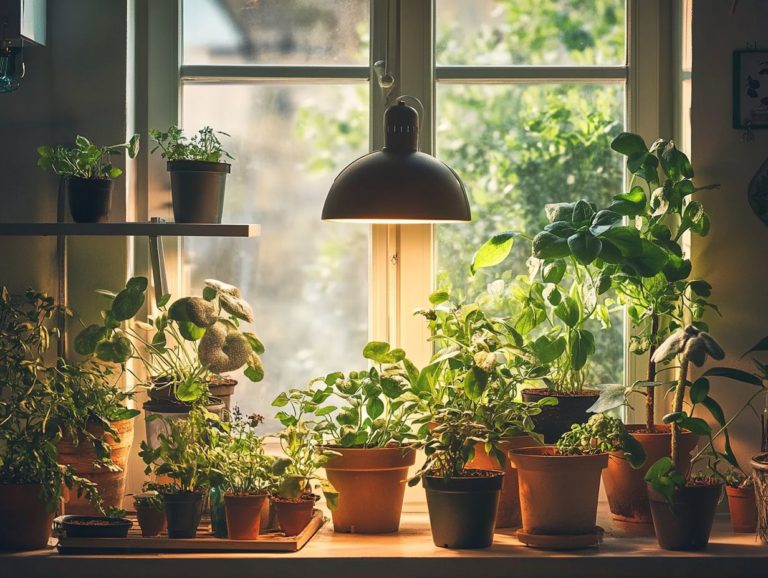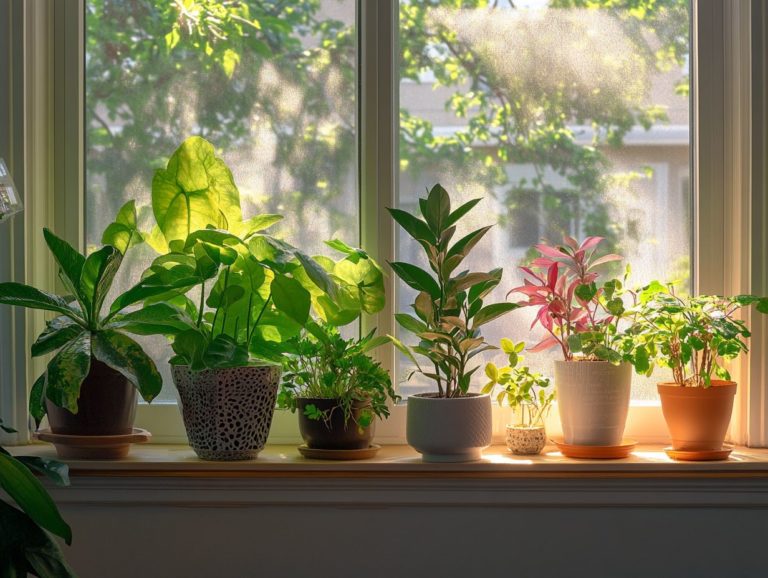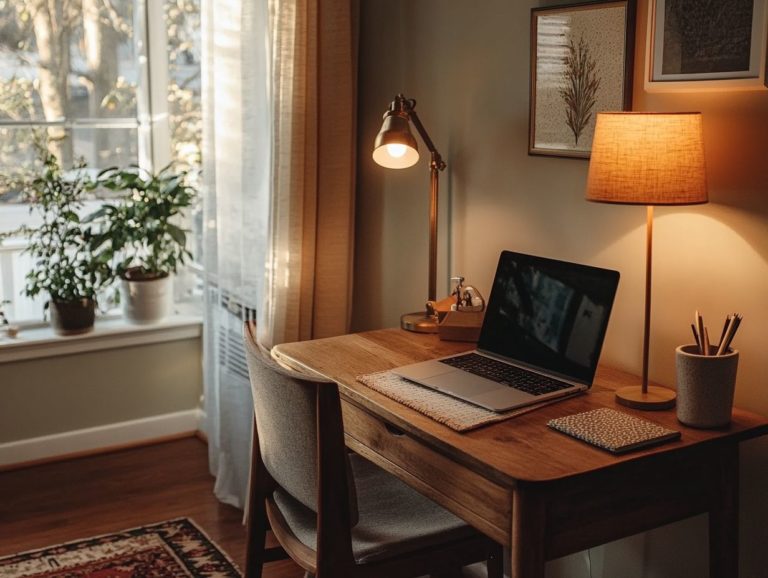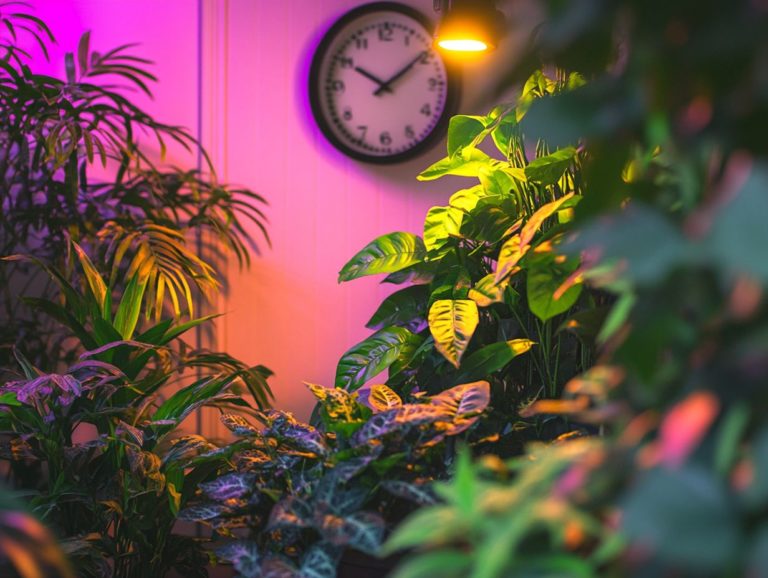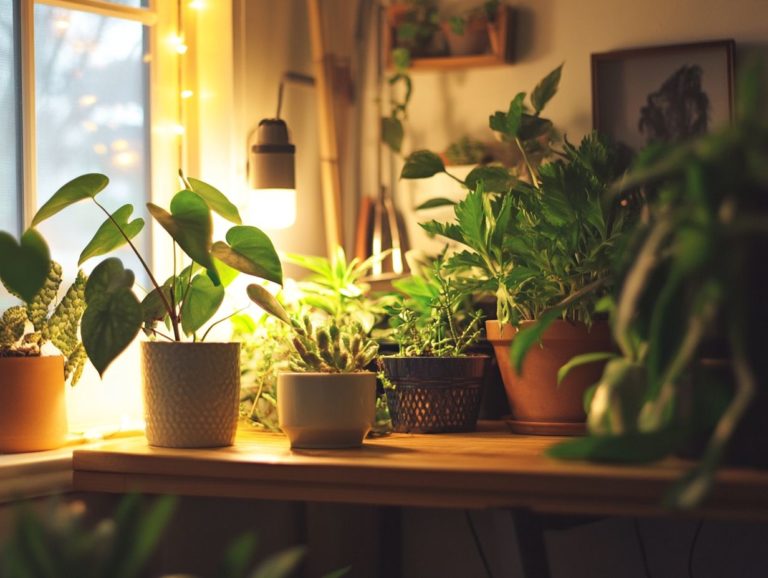Identifying Light Needs of Various Plants
Ready to unlock the secret to vibrant, thriving plants? Light serves as a cornerstone for the growth of plants, intricately influencing their the process of photosynthesis, energy production, and overall vitality.
In the realm of indoor gardening, understanding your plants’ specific lighting needs can significantly impact their growth. Whether you have houseplants that crave direct sunlight or those preferring dimmer environments, the right lighting conditions are crucial for success.
Adequate exposure to light not only fosters robust growth but also infuses your plants with vibrant colors, elevating the aesthetic charm of your space.
Contents
- Types of Light and Their Effects on Plants
- Key Takeaways:
- Identifying Light Needs for Different Types of Plants
- Factors Affecting Light Needs of Plants
- Providing Adequate Light for Optimal Plant Growth
- Frequently Asked Questions
- Understanding Light Needs for Houseplants
- How do I identify the light needs of my plants, including sunlight exposure?
- What are the signs of plants not getting enough light?
- How much sunlight is considered full sun for plants?
- Can indoor plants thrive without direct sunlight?
- What are some ways to provide adequate light for plants?
Understanding Photosynthesis and Light Requirements
Photosynthesis is the fascinating process that allows plants to transform light energy into chemical energy, a crucial mechanism for their growth and survival.
This remarkable journey unfolds in several stages, starting with chlorophyll’s ability to absorb sunlight. The initial phase takes place in the thylakoid membranes, which are small structures in plant cells where the magic of sunlight absorption begins, where light-dependent reactions generate energy carriers. These carriers then power the conversion of carbon dioxide and water into glucose during the Calvin cycle, a series of reactions that convert carbon dioxide and water into glucose. It’s intriguing how different plant types have unique light conditions that significantly impact their growth.
Take the Fiddle Leaf Fig, for example. It thrives in bright, indirect light essential for those large, lush leaves to truly flourish. On the other hand, the ZZ Plant prefers low-light conditions, showcasing its resilience by effectively using minimal light energy. These adaptations show the incredible variety in the plant kingdom. Understanding light quality for plants is vital for their thriving.
Types of Light and Their Effects on Plants
Understanding the different types of light available for your plants is essential for optimizing their growth. Both natural and artificial light sources play a significant role in influencing their health and vitality.
By grasping the nuances of light, you can create the ideal environment for your plants to thrive.
Key Takeaways:

- Understanding the importance of light for plant growth and how it affects photosynthesis is crucial in identifying light needs for various plant types.
- Different types of light, including natural and artificial, can influence plant growth and should be factored into your light requirements.
- The specific light needs of plants can vary based on their classification as low, medium, or high light plants, as well as factors such as location, season, and plant age. These considerations should be taken into account when providing adequate light for optimal plant growth.
Natural vs. Artificial Light
Natural light offers an important range of light that significantly benefits plant growth. Artificial light, on the other hand, can be precisely tailored to meet the specific light conditions your plants require.
Striking an effective balance between these two light sources is essential for your indoor gardening success. Many houseplants thrive under natural light, as it closely mimics their native environments. However, not every home receives ample sunlight year-round. In those scenarios, you’ll often need to incorporate lighting considerations for plant growth along with artificial lighting.
The versatility of LED or fluorescent options allows you to adjust intensity and duration to cater to the various light requirements for flowering indoor plants. By understanding the unique needs of each plant, you can create an ideal environment that ensures they receive enough energy to flourish. This prevents the pitfalls of overexposure, which can lead to stress or damage.
Full Spectrum vs. Specific Spectrum

Full spectrum lights provide a wide range of wavelengths that closely resemble natural sunlight. Specific spectrum lights focus on particular wavelengths to enhance growth.
This versatility is especially advantageous for you as an indoor gardener. You likely manage various types of plants, each with distinct lighting needs for optimal development. For instance, leafy greens and herbs flourish under full spectrum lights that support their growth phases. To ensure you’re meeting these needs, refer to guidelines for understanding indoor plant light needs.
Flowering plants might respond better to specific spectrum lights that emphasize red and blue wavelengths. By selecting the right lighting, you can effectively simulate seasonal changes and meet the unique needs of your plants. For more insights, refer to understanding the light spectrum for plants, which maximizes photosynthesis—the process plants use to make food using light—and overall yield.
Knowing these details helps you choose the right light for each plant, ensuring that every type receives the most suitable light for robust growth, regardless of the surrounding environment.
Identifying Light Needs for Different Types of Plants
Identifying the light requirements for various types of plants is crucial for your indoor gardening success. Every plant has its own special needs, and understanding these can significantly impact their growth and overall health.
Low Light Plants
Low light plants are your best bet for indoor spaces that don t receive sunlight, thriving where others fail. They make perfect companions in offices, apartments, or homes that favor convenience and style over bright, sun-drenched environments.
Take the ZZ Plant, for example. This beauty is known for its incredible resilience; it thrives on indirect light and minimal watering, doing best when you let it dry out between drinks. Then there’s Dracaena, which comes in a variety of striking forms. While it can adapt to lower light, it enjoys a touch of indirect sunlight to keep those vibrant colors and upright growth looking sharp. To enhance your plants’ lighting conditions, consider using light shades for indoor plants.
To keep your green friends happy, be sure to monitor the soil moisture and resist the urge to overwater. Allow the soil to dry out between waterings, and don t forget to give the leaves an occasional dusting. This small act enhances their ability to photosynthesize, ensuring they continue to thrive even in dim conditions.
Medium Light Plants
Medium light plants strike the perfect balance between direct and indirect sunlight, making them versatile choices for your indoor spaces.
Take Pothos, for example. This resilient plant boasts stunning variegated leaves and has a remarkable ability to adapt to varying light conditions. Position your Pothos near a window where it can bask in filtered light. For optimal growth, consider identifying the right light for ferns. Just be mindful to shield it from those harsh rays that could scorch its leaves.
Regular watering is crucial, but moderation is key; let the top inch of soil dry out before you reach for that watering can again. Pothos prefers average humidity but enjoys a bit more moisture for optimal health.
Consider showcasing it high on a shelf or in a hanging basket, allowing those lovely trailing vines to cascade elegantly. Explore different light options today to give your plants the best chance to thrive!
High Light Plants
High-light plants crave ample exposure to direct sunlight to flourish and showcase their vibrant foliage.
For instance, plants such as the Fiddle Leaf Fig, Bird of Paradise, and Golden Pothos thrive in bright environments where they can fully absorb the sun’s rays. Give them about six hours of direct sunlight each day.
Let the soil dry out slightly between waterings to prevent root rot, a condition where roots decay due to excess water. Choosing well-draining potting soil is crucial, as it helps retain moisture while ensuring adequate drainage. Don t forget to select a pot with drainage holes; this simple step keeps the roots healthy and avoids standing water.
Factors Affecting Light Needs of Plants
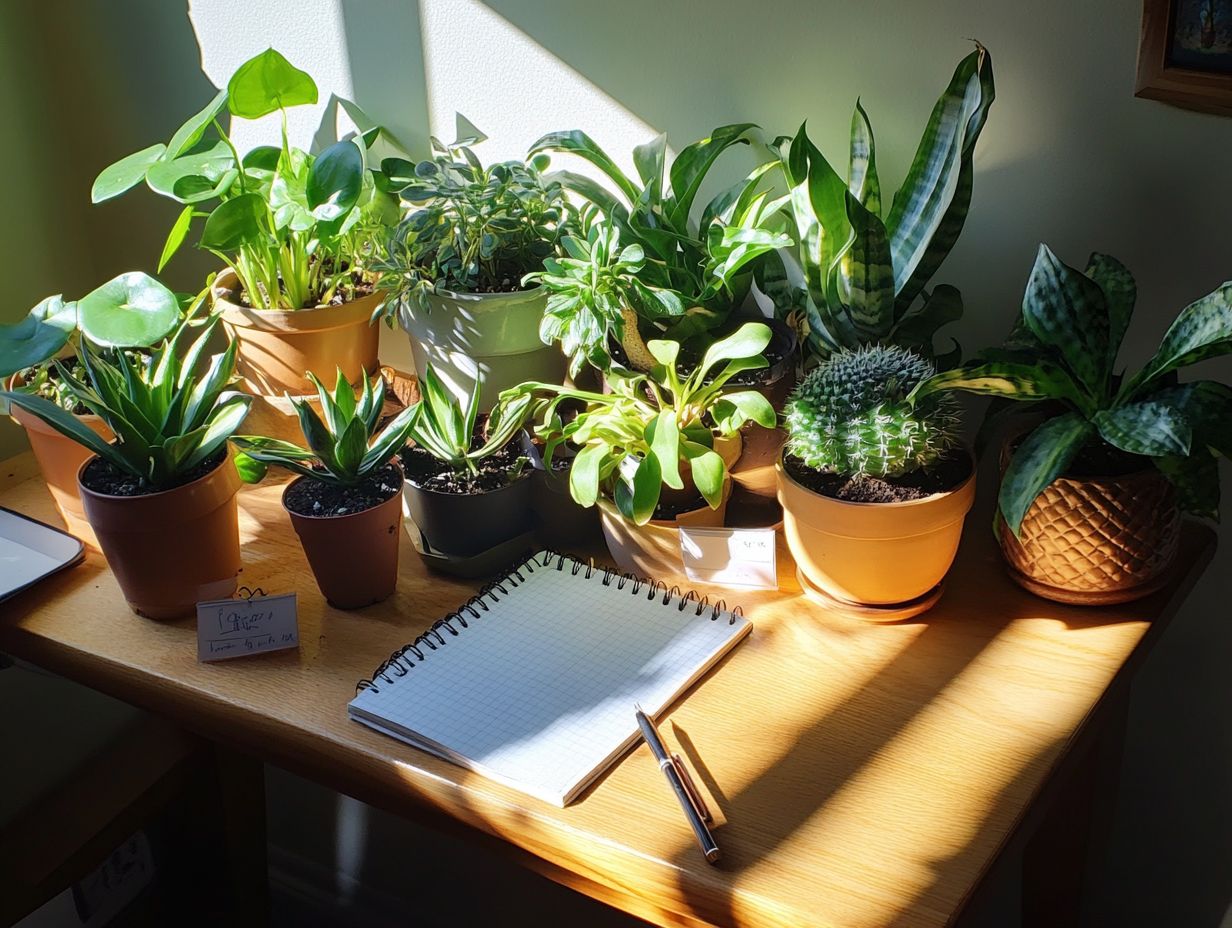
Numerous factors influence the light requirements of your plants, including their location, seasonal variations, and their age. Each plays an important role in your plants’ health.
Location, Season, and Plant Age
The placement of your plants within your home, the changing seasons, and their age shape their light needs.
A south-facing window generally provides the brightest light, making it perfect for sun-loving varieties. In contrast, a shaded corner may be ideal for low-light plants.
As the seasons change, you must monitor light levels. In winter, when natural light diminishes, repositioning may be necessary to guarantee your plants receive adequate illumination.
As your plants mature, their requirements can shift as well. A young houseplant, such as a succulent, might thrive in direct sunlight, but as it grows, it could prefer filtered light to avoid scorching. Understanding the science of light and plant care can help you keep a vigilant eye on these factors, ensuring that your plants truly thrive.
Providing Adequate Light for Optimal Plant Growth
To ensure optimal growth, your plants need the right light. Use various techniques to assess and adjust light levels based on the unique needs of each plant.
Tips and Techniques for Adjusting Light Levels
Implementing effective strategies for adjusting light levels can significantly enhance the growth of your indoor plants.
Use grow lights to mimic natural sunlight. Position them correctly to avoid leaf burn while ensuring proper growth. Regularly reposition your plants to maintain balanced exposure throughout the day.
To fine-tune their light requirements, watch the changing light conditions in your space. Timely adjustments encourage strong, vibrant growth, especially in tropical plants.
Frequently Asked Questions
Understanding Light Needs for Houseplants
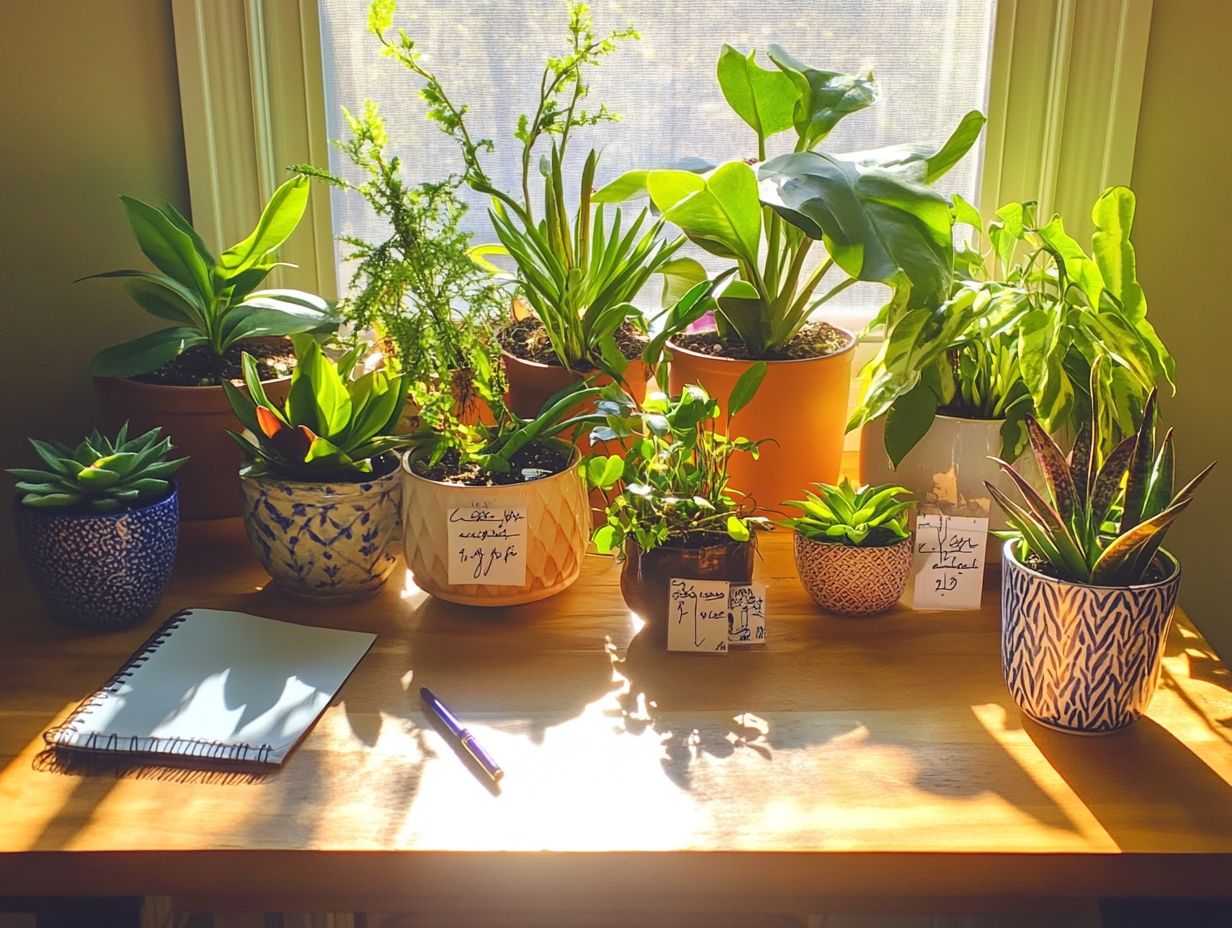
Plants have different light needs, including full sun, partial sun, partial shade, and full shade. Some require direct or indirect sunlight. Researching your plants’ specific needs is essential for their thriving.
How do I identify the light needs of my plants, including sunlight exposure?
The best way to identify your plants’ light needs is to research their specific needs. Consult gardening books, websites, or talk to a local gardening expert. Observing your plants’ growth patterns can also provide insight.
What are the signs of plants not getting enough light?
If you see pale leaves or stunted growth, your plant likely needs more light. Move it to a brighter spot. Signs of insufficient light include leaning towards a light source, wilting, or dropping leaves.
How much sunlight is considered full sun for plants?
Full sun typically means 6-8 hours of direct sunlight per day. This can vary based on the plant type, so it’s crucial to understand your plants’ specific sunlight requirements.
Can indoor plants thrive without direct sunlight?
Yes, many indoor plants can thrive in low to medium light conditions without direct sunlight. Examples include pothos, snake plants, and Chinese evergreens, which have adapted to survive in low light and may be damaged by excessive direct sunlight.
What are some ways to provide adequate light for plants?
To provide adequate light for your plants, place them near a window with natural sunlight. You can also use artificial lighting, such as grow lights, to supplement natural sunlight. Adjust the light and duration based on your plants’ needs to help them flourish!

